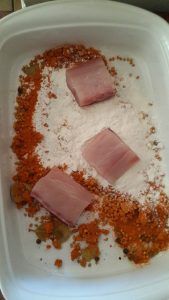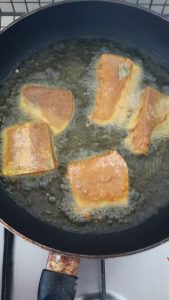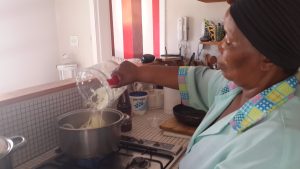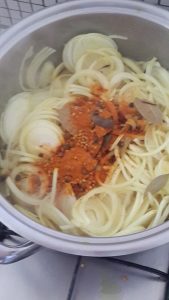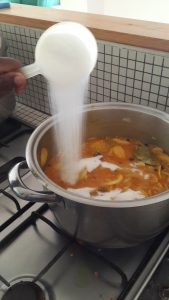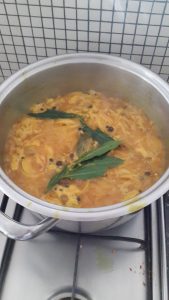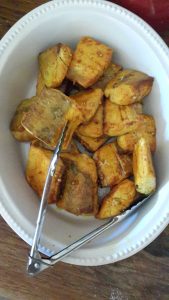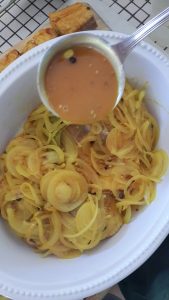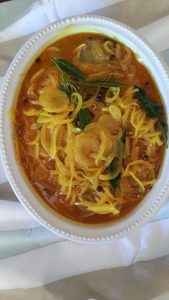Having lived in Cape Town for 20 years now, I still wonder why this beautiful city with her very colourful past lacks a unique, celebrated seafood dish to call her very own. We do have smoorsnoek – that delicious braise of salted or smoked snoek, onions, tomato, chilli, potato and rice – though it is a homely dish seldom seen on restaurant tables. And more’s the pity, I’d say: I’ve made delicious fishcakes from leftover smoorsnoek, all nice and crisply crusted on the outside, served with a generous dollop of aioli and a vinegary tomato-onion sambal on the side.
Whole fish, or the ubiquitous snoek once again, braaied on the coals with a baste of apricot jam is another local speciality, but it scarcely entails sufficient skill or technique to qualify as ‘real’ cuisine, nor does serving it formally do it proper justice. Braaied fish tastes best when cooked right next to the ocean anyway, seasoned with little more than butter, lemon and salt.
One recipe that does seem to fit the bill, that comes with a proper Cape cuisine pedigree and all the pomp and circumstance that befits a celebration dish, is pickled fish. Also known as curried fish, it seems to be most popular during the summer holidays, on Christmas or Boxing Days, and most especially during Easter weekend. It keeps for several days, even without refrigeration, doesn’t spoil easily and is an affordable dish with which to feed a multitude. There are similar dishes in many different cuisines, like the Venetian fish in saor, Filipino fish en escabeche and even Jamaican escoveitch, but the Cape version is unique for its addition of Cape Malay curry spices.
It’s also very much a regional speciality, since few people in the interior know it or serve it and then never as a celebration dish. (Mind you, I do recall my father enjoying the odd tin of kerrievis with unseemly glee occasionally, but I suspect it might have had something to do with marital quarrels, and there was a little cupboard in my mother’s kitchen stocked especially with tinned food for my father for occasions like that.)

Once home, I consulted my old standby kitchen bible for all things traditional, Dine van Zyl’s Boerekos – Tradisionele Suid-Afrikaanse resepte. Just in case…
Atlas Trading’s recipe seems very brief, and Dine’s recipe requires the spices to be measured individually. I was in a hurry. Having the ready-made spice mix, I decided to combine the two recipes after a fashion, adding my own twist here and there. Dine adds tomato sauce, which we left out, and she uses a lot more vinegar and less sugar than Thando and I did. Neither Atlas Trading’s nor Dine’s recipe contains Thando’s Number One Pickled Fish Tip: ‘do not cook the fish all the way done, and turn-turn-turn’ before ladling over the marinade. The hot pickling sauce and the vinegar will cook the fish sufficiently, Thando says, adding that you must trust these things.
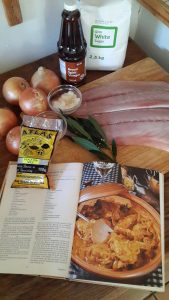
For 2 kg fish, filleted and portioned, you’ll need 5 large onions, thinly sliced. Use a food processor for this if you have one. If you can’t get your hands on a ready-made pickle fish spice, mix 4 Tbsp strong curry powder, 2 Tbsp turmeric, 1 Tbsp coriander seeds, 2 tsp cumin, 1 tsp black peppercorns, 8 whole cloves, 6 cardamom pods, 10 dried or fresh bay leaves, half a bottle strong brown vinegar, salt and about 3/4 cup white sugar. Allspice berries are rare, but if you can find some, add 8.
Mix 1 Tbsp of the spice mix with 1/2 cup cake flour on a plate and roll the fish portions in it to coat lightly. Fry a few pieces of fish at a time in hot oil, turning several times – about 3 -4 minutes on each side, and drain on absorbent paper. Once all the fish has been fried, decant the oil into a large pot, add all the sliced onions and the rest of your spice mix, and stir through. Cook to soften for about 10 minutes, then add all the vinegar and enough water to cover the onions. Stir in the sugar, season with salt and bring to a brisk boil for 10 minutes.
Meanwhile, cover the bottom of a non-reactive dish with one layer of fish pieces. Use a slotted spoon to ladle a layer of softened onions over the fish, and then pour over some of the pickling sauce. Repeat with another layer of fish and onions until you’ve used it all up. Pour over sufficient pickling sauce to cover your fish and onions, and let it stand until completely cooled before placing in the refrigerator. The fish will be ready to eat after 24 hours, and will keep nicely up to 5 days if refrigerated.
Best enjoyed cold, with a little of the sauce and a lot of the onions spooned over, and lots of bread and butter on the side.
